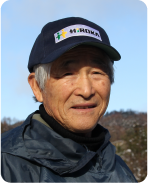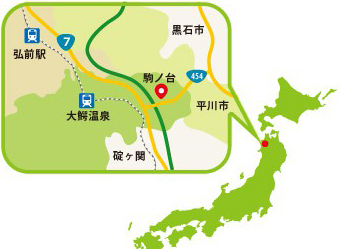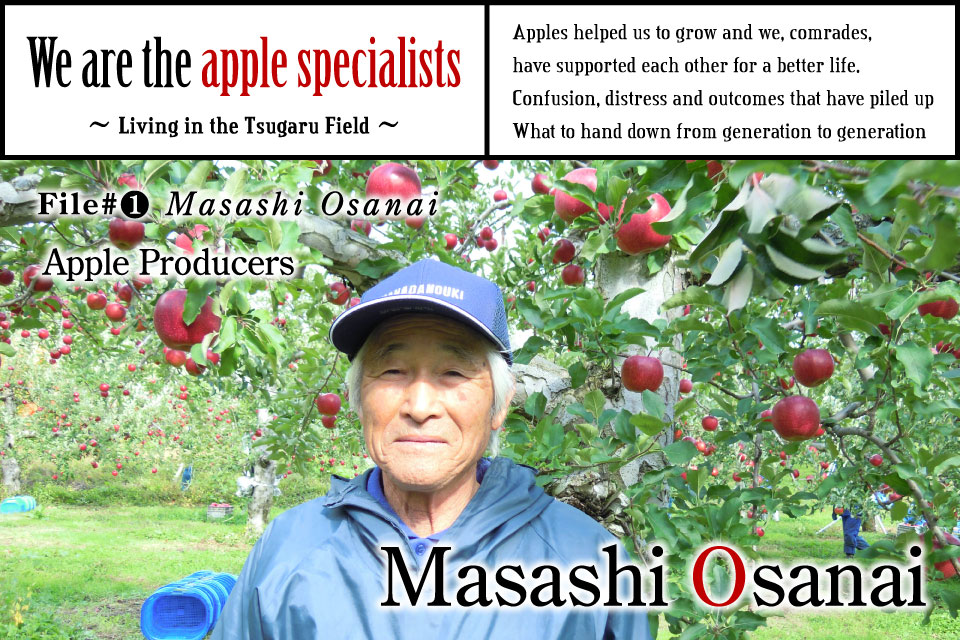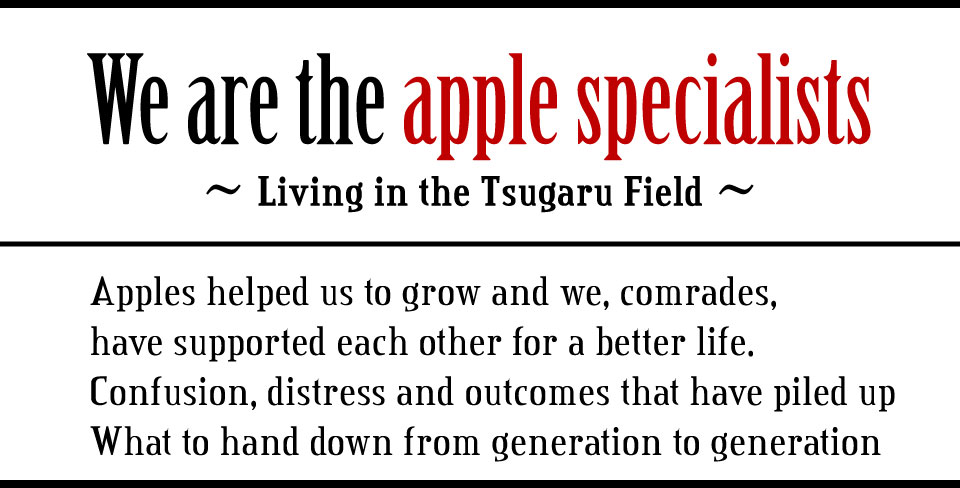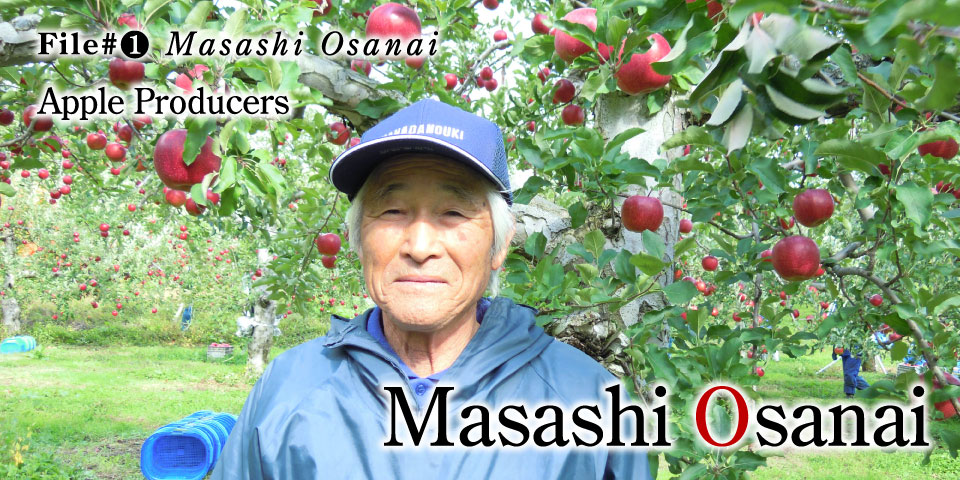There is a man in the highlands, at an altitude of 300 meters, who has followed his beliefs.
His unwavering will was inherited from the pioneers who dreamed of a utopia.
In fall, the sparkling red fruit departs from this small village in the mountain out to the world.
The challenge of the man who was inspired by apples hasn’t finished, even after half a century.
File#① Masashi Osanai
Elevation: about 300m. The Komanodai area of Owani, Aomori is located at the first or second highest altitude for apple growing in Aomori prefecture. Different from the flatlands, the highlands have many more slopes, which makes the work inefficient. In addition, more snowfall makes pruning more difficult. Also, the difference in temperature of day and night is necessary for apple growing. Coldness dominates in this area and less warmth makes the fruit smaller. On the other hand, the coldness brings the apples brighter coloring, crisper texture and more delicious flavor. Better storage capability and long term refrigeration has helped the apples gain popularity. However, there is grower’s distress about the difficulty of increasing yields.
Masashi Osanai has cultivated apples for about the last 65 years in this land. As soon as you come to the over-look view of the
entrance of this village, a sign and a stone monument jump into view. The sign says, “Komanodai, the frontier spirit.” The
belief that the young pioneers held for an ideal utopia is carved onto the monument.
In 1936, Osanai was born as the first son of the family. It was the upheaval age of the war. His father was one of the frontiers to settle down in Komanodai. It was a small colony of 30 households in the mountain. It took him more than one hour to walk to the nearest elementary school. Being an unruly boy, he chose to help the family after graduating from elementary school. Since it was right after the colonization, there were many inconveniences with farming. He recalls, “I used to carry a hand pump on my shoulder to the orchard to spray chemicals.”
At that time they grew various vegetables, including potatoes and soy beans. A few years later they started cultivating apples, the traditional and main cultivars called “Jonathan” and “Ralls Genet.” He succeeded his father and grew apples as well. However, at first he wasn’t all that interested in apple growing, with no strong motivation to do so.
Gradually the second generation of the pioneers gathered and worked hard to cultivate apples as one community. But with the highland features of the location, they struggled with strong winds. Especially the east wind, called Yamase, which critically impacted late blooming and the dropping of fruit. Even though they stayed on the trees, the remaining fruit had scratches all over the surface.
“It was a disastrous place to cultivate apples.”
But they planted many cedar and pine trees as a wind break forest. No one gave up. They faced the challenges of apple cultivation head-on.
here must be something that I can only do here.
In around 1972 to 1973, Osanai, in his 30s, heard about Takegoro Tsushima, who achieved the success of “Star-king” apple growing at the foot of Mt. Iwaki. Mr. Tsushima was asked to grow two “Star-king Delicious” seedlings, which were imported from America by Mr. Yoshimasa Saito of the Senbikiya Fruit Shop in Ginza, Tokyo. Saito successfully grew this new cultivar and exceeded the production of “Jonathan” and “Ralls Genet” apples, thus establishing the “Era of Star-king” apples in the Funazawa area.
Osanai thought, “I’d like to accomplish something like that on the top of this mountain.”
Just at this time, when he went to buy bags for apples, the shop owner ridiculed him and said, “Are you still producing “Jonathan” and “Ralls Genet” apples?” This incident thoroughly motivated him. Things could not be left as they were. Something had to be done to change the present situation.
Growing apples in the highland area is thought to result in a smaller sized harvest and a smaller fruit size than in the flatlands. It was necessary to choose a cultivar that grows well, with good coloring caused by a larger hillside temperature difference. So, Osanai aimed for “Mutsu” apples. In those days, “Mutsu” apples were not popular any more. Osanai became a pioneer and a leader when he started using bags on the “Mutsu” variety, originally a green apple. He had the spirit of the pioneers, so he never stopped challenging himself. He put his heart and soul into growing “Mutsu” apples without any doubts.
“Mutsu” is a variety that requires much care, such as needing to be bagged twice. It is also hard to get perfect coloring. The climate particular to the highland of Komanodai suited “Mutsu” well. And he was altogether attracted by the unique rose-red color of “Mutsu.”
“People of that time, including producers, wholesalers and buyers in the market, were sharing the same kind of hope for apples,” Osanai said.
Never being pushy but active and helpful, Osanai soon became the leader of the community, encouraging and supporting peer growers. “Someone has to be the one to break new ground,” he said. He and others in Komanodai united and grew “Mutsu” ambitiously. The reputation of their “Mutsu” apples for their coloring soon spread far. At harvest time, a mass sale called the “Mutsu Festival” was held in the market and was greatly successful. Especially successful were the ones from Komanodai, which received a superior value and high bids.
Osanai, the leader of Komanodai, later became the second president of the Hiroka Apple Liaison Council and has led the community of apple growers in the Tsugaru area as a reliable figure.
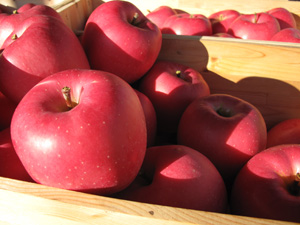
For further information on “Mutsu,”please visit here.
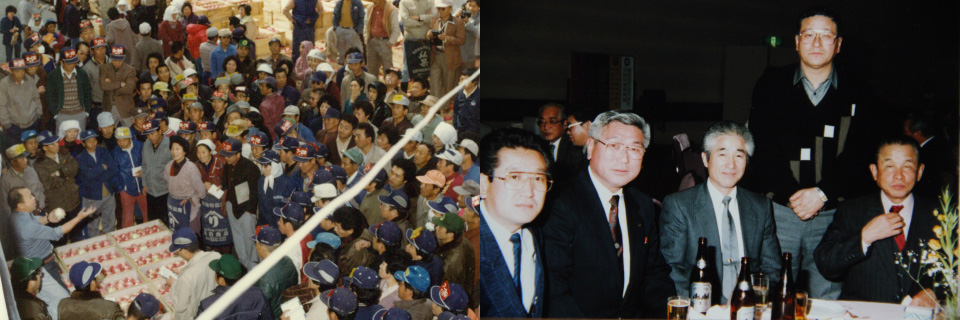
(right) In 1989, at the year-end party The man in the middle is Osanai.
Unable to beat the power of nature
At the age of 55, during his term of office as the president, in the early morning of September 28, 1991, the unprecedented and huge typhoon #19 hit the Tsugaru area, the so-called “Apple Typhoon.” With a maximum wind speed of more than 50 m/second, it left horrifying scars all over the Tsugaru area. Utility poles were knocked down in every corner of the streets, many buildings were collapsed and tin roofs were blown away.
“It was all right when I went to see my field at 5 in the morning,” Osanai said.
But a few hours later, he was stunned to see the shocking scene in his field.
“The fruit won’t fall even if you hit the branches. But then they completely fell to the ground.”
The “Mutsu” apples received devastating damage. Unfortunately, since he didn’t join the mutual insurance program, his income that year was almost nothing. His peers, of course, were also not covered by any insurance. But nobody from the group quit growing apples. They supported each other that year and survived. They built anti-wind nets to prepare for the next typhoon. But they learned the lesson, once again, about how hard it is to grow apples in this particular highland landscape.
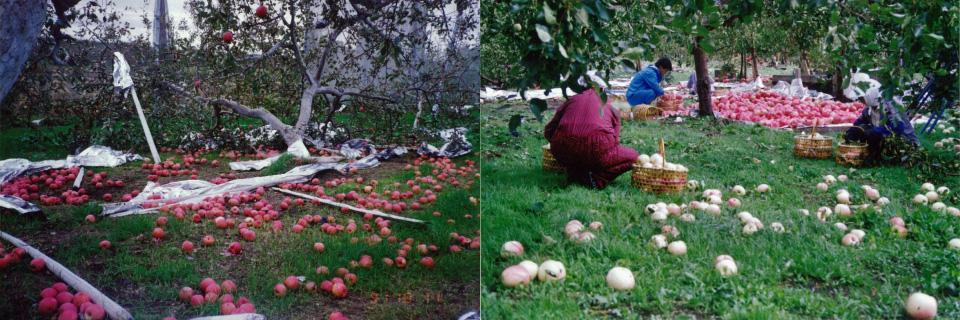
Twenty-three years later on September 12, 2014, it hailed in big sizes in the Tsugaru region. Komanodai was no exception, and the hail pellets covered and stayed in the whole field until the next morning without melting. The apples were damaged just a month away from harvesting. (Hail damaged apples tend to sell at lower prices.)
But Osanai decided not to dispose of the damaged fruit and started to rotate every fruit to get sunshine properly. There wasn’t noticeable hail damage when looking up at the trees, but he found scars on most apples when he cropped them.
“It must be that gigantic hail fell, I thought,” he recalls. He observed many scratches on the tree branches while looking down from a ladder.
Even though he realized that humans are incompetent against the rage of Nature, he completed the harvest of fine apples without any defect in taste. And he survived the year, even with a large decrease in income.
He has faced the battles of nature while growing apples year after year.
The only challenge left for the new cultivar, “Daikouei”
After experiencing the “Ringo Typhoon,” he was searching for the way forward. The blooming of flowers in the Komanodai area is 10 days later because of the deep snow in the highlands. Also, the speed of fruit growth is slow toward fall, thus the size of the fruit tends to be smaller than those of the flatlands. It was successful to cultivate “Mutsu” apples, one of big sizes of apple, which suited the climate of the highland. But it required a lot more care than the other varieties and it became a burden to the growers. He searched for a better cultivar requiring less labor than the “Mutsu” variety.
One day Osanai’s first son, who was training at an apple orchard, came back with a few branches that were handed to him by the owner of the orchard. It was Osanai’s first encounter with “Daikouei,” a cultivar.
“I decided to try growing them without taking a closer look,”
he laughed heartily. It was the same impulsivity as the time when he decided to become a farmer at age 12, or the time when he decided to plant “Mutsu” knowing that the popularity of it had died down. He is determined when it is necessary. There was no doubt about his action. Taking a gamble, Osanai grafted those branches and grew with care, expecting the results in a few years.
And he was right about his impulse. “Daikouei” apples turned out to be a cultivar of good coloring and were highland climate friendly.
“’Daikouei’ apples are nice looking and have a good taste. I believed that this would serve as a substitute for ‘Mutsu’ apples,”
he thought. Presently the volume of production reaches about 1200 tons, which matches up evenly with that of “Mutsu.”
There is an advantage for “Daikouei” producers in that they don’t need to bag the fruit, thus less labor is needed. Furthermore, this cultivar produced in a higher altitude gets better coloring and flavor because of the temperature difference of night and day. At an age of over 60 at that time, Osanai made up his mind to spend his time together with “Daikouei” apples for the rest of his life. 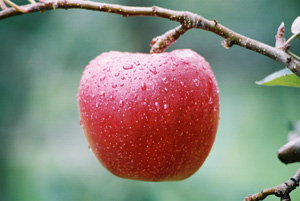
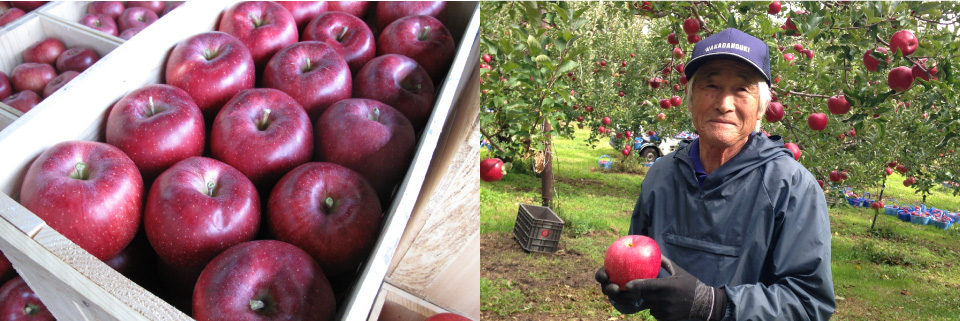
Search and think all by myself
There are apple cultivars suitable for mountains and others for flatlands.’
In the mountains where there are more and earlier snow falls, trees with lingering leaves are easily damaged by snow. Osanai tells the significance of variety configuration in the orchard.
“To select the best suitable variety is the most important. I see many fields that have scattered varieties in one place.”
It is indispensable to utilize the land’s characteristics when choosing a cultivar. “You shouldn’t randomly grow a variety, but you need to find yourself the most suitable one for each area.”
And the one he found was “Daikouei.”
And he adds, “You need to cope with your peers to produce apples. You should care for each other and support each other during times of suffering. Then you can endure and try hard for a better outcome.”
With a snowfall of 1.5 to 2 meters in the highland winter, this land is academically considered to be an impracticable place to grow apples. Still, he has never lost his frontier spirit and coexists with nature together with his comrades of the same motivation.
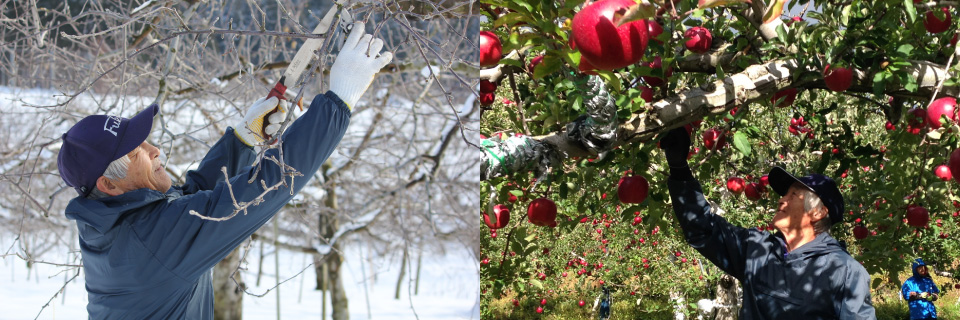
(right) The present orchard of “Daikouei” apples
The family and his comrades
At age 80, he has been interested in photography since his youth, and traveled to take pictures of landscapes. Also, he used to take pictures of people in his community and give them as presents. In his 50s, he even won a prize at a Kuroishi Photo Contest.
He now spends his off days mainly relaxing. One of his favorite activities is touring hot springs. He regularly goes to Wanikamu, a spa in Owani town, these days. The spa is managed by his friend, Takao Yagihashi, who grows apples in Komanodai as well. For decades they have been old friends and shared the same suffering and joy in the same area.
“Osanai is a man of plant observation. And he is persistent with his ideas,”Yagihashi admires. On the other hand, he says, “Osanai is really stubborn, an obstinate person.”
Knowing his friend so well, Yagihashi laughs away with a little joke. This kind of exchange with a friend gives Osanai regenerative power.
Now his most joyful concern is to watch the growth process of “Daikouei.” He thoroughly cares for his health so that he can keep working with energy.
And the source of this energy is drinking and singing.
He experiences a blissful moment when he sips Shochu, clear liquor, and watches his favorite popular song program on TV. When he was in the chair of the president, he used to sing with a price on his good voice at year-end parties, exciting people.
Having been married for more than 50 years, Osanai, his dear wife, and their first son together are united to work vigorously.
“Not only us, but most of the households in Komanodai are producing apples with the three generations.”
From parents to children, from children to grandchildren, the passion of the pioneers is inherited. Osanai, however, doesn’t interfere in matters of the young, only gives them some advice when he is asked.
“Do as you like.” Decide your way by yourself.
These words are how he has lived his life in everything that he has done: he kept taking on challenges, took actions by considering all by himself, and produced results.
Through his gentle smile, a young-looking, strong and powerful light gleams in his eyes.
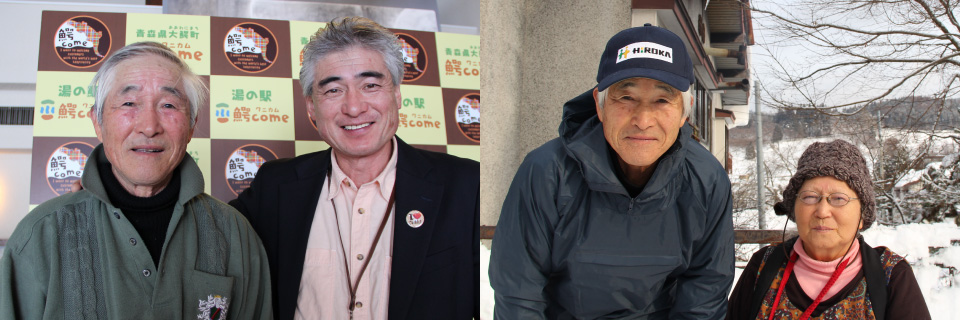
(right) He cannot thank his wife of more than 50 years enough for her full support.
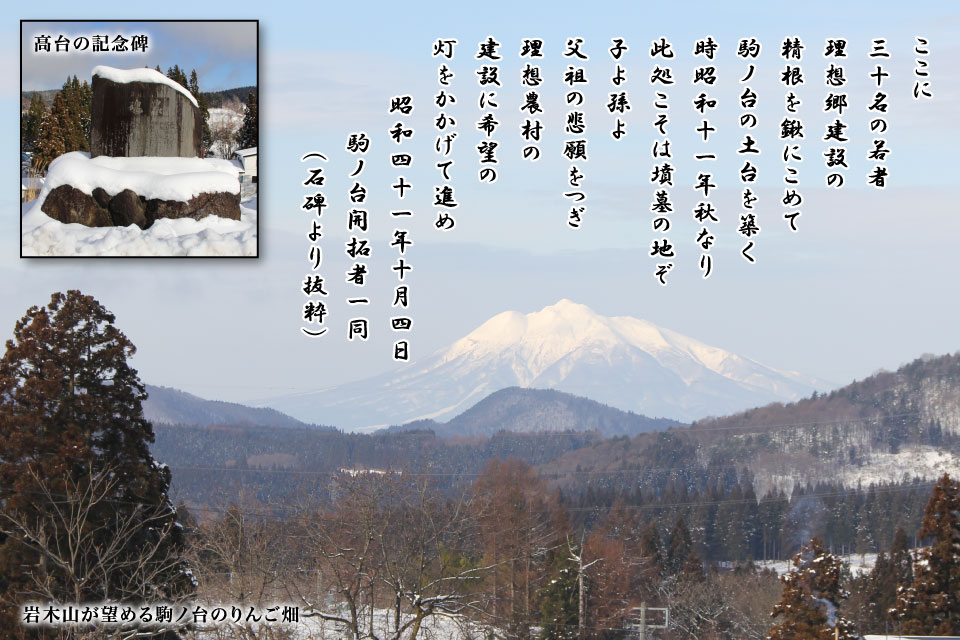
Thirty young men
Built the base of Komanodi
With all their energy in hoe
To construct the ideal utopia
It was the fall of 1936
It is where the tombs should be
Children and grandchildren,
Proceed your way with a lantern of hope
For the construction of the ideal village
To tread in fathers’ footsteps
October 4, 1966
All pioneers of Komanodai
(Extracted from the monument)
Written in December 2016
Released December 2016
profile : Masashi Osanai
